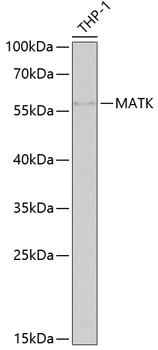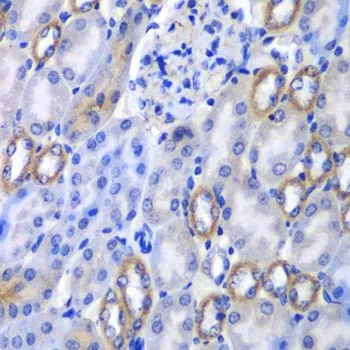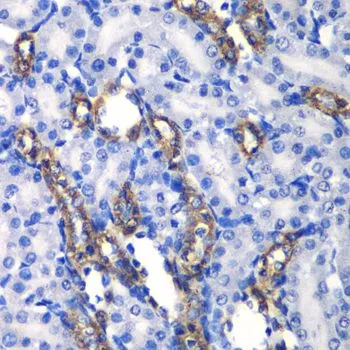
WB analysis of THP-1 cell lysate using GTX64561 MATK antibody. Dilution : 1:1000 Loading : 25microg per lane
MATK antibody
GTX64561
ApplicationsWestern Blot, ImmunoHistoChemistry, ImmunoHistoChemistry Paraffin
Product group Antibodies
TargetMATK
Overview
- SupplierGeneTex
- Product NameMATK antibody
- Delivery Days Customer9
- Application Supplier NoteWB: 1:500 - 1:2000. IHC-P: 1:50 - 1:200. *Optimal dilutions/concentrations should be determined by the researcher.Not tested in other applications.
- ApplicationsWestern Blot, ImmunoHistoChemistry, ImmunoHistoChemistry Paraffin
- CertificationResearch Use Only
- ClonalityPolyclonal
- ConjugateUnconjugated
- Gene ID4145
- Target nameMATK
- Target descriptionmegakaryocyte-associated tyrosine kinase
- Target synonymsCHK; CSK homologous kinase; Csk-homologous kinase; Csk-type protein tyrosine kinase; CTK; hematopoietic consensus tyrosine-lacking kinase; HHYLTK; hydroxyaryl-protein kinase; HYL; HYL tyrosine kinase; HYLTK; leukocyte carboxyl-terminal src kinase related; Lsk; megakaryocyte-associated tyrosine-protein kinase; protein kinase HYL; tyrosine kinase MATK; tyrosine-protein kinase CTK; tyrosylprotein kinase
- HostRabbit
- IsotypeIgG
- Protein IDP42679
- Protein NameMegakaryocyte-associated tyrosine-protein kinase
- Scientific DescriptionThe protein encoded by this gene has amino acid sequence similarity to Csk tyrosine kinase and has the structural features of the CSK subfamily: SRC homology SH2 and SH3 domains, a catalytic domain, a unique N terminus, lack of myristylation signals, lack of a negative regulatory phosphorylation site, and lack of an autophosphorylation site. This protein is thought to play a significant role in the signal transduction of hematopoietic cells. It is able to phosphorylate and inactivate Src family kinases, and may play an inhibitory role in the control of T-cell proliferation. This protein might be involved in signaling in some cases of breast cancer. Three alternatively spliced transcript variants that encode different isoforms have been described for this gene. [provided by RefSeq, Jul 2008]
- Storage Instruction-20°C or -80°C,2°C to 8°C
- UNSPSC12352203



![FACS analysis of K562 cells using GTX83311 MATK antibody [9D7]. Green : MATK Purple : negative control](https://www.genetex.com/upload/website/prouct_img/normal/GTX83311/GTX83311_20170912_FACS_w_23061322_663.webp)



